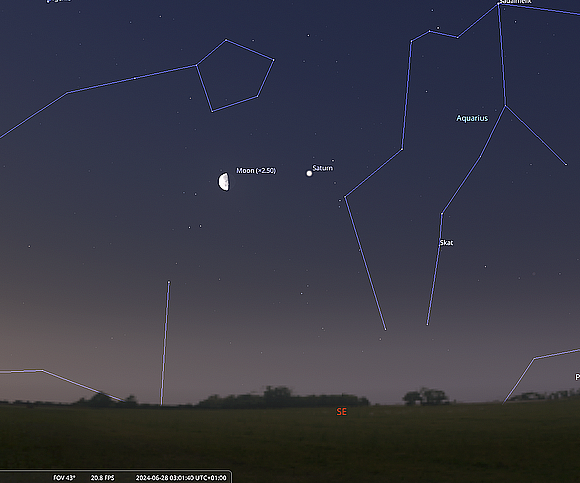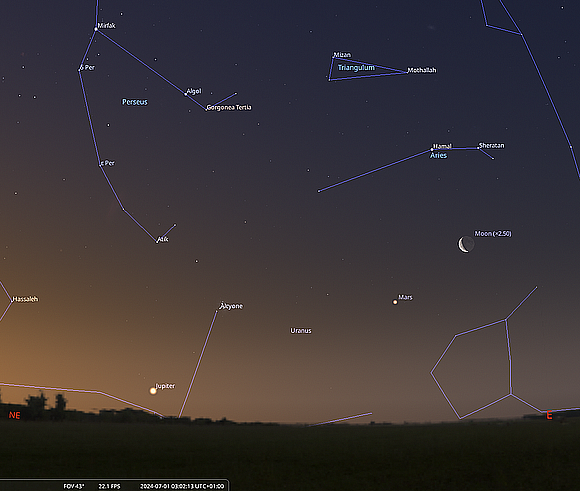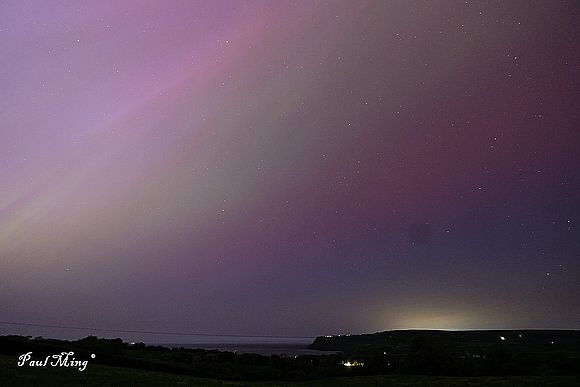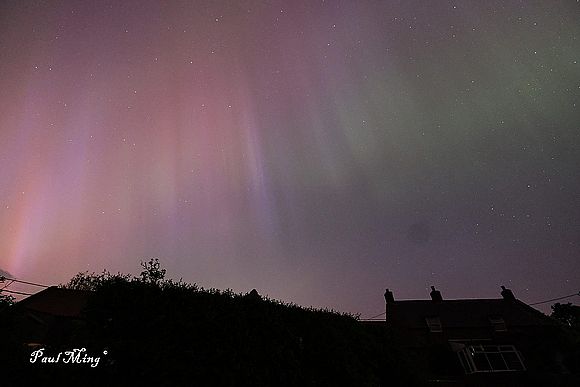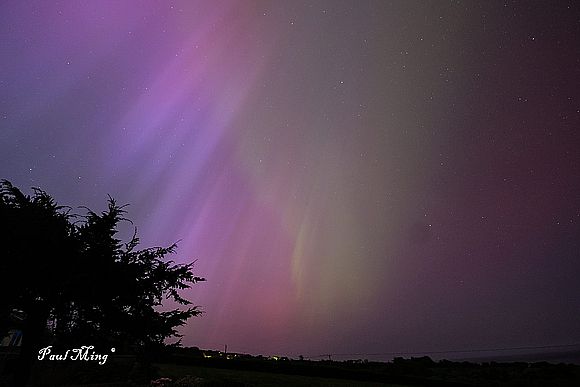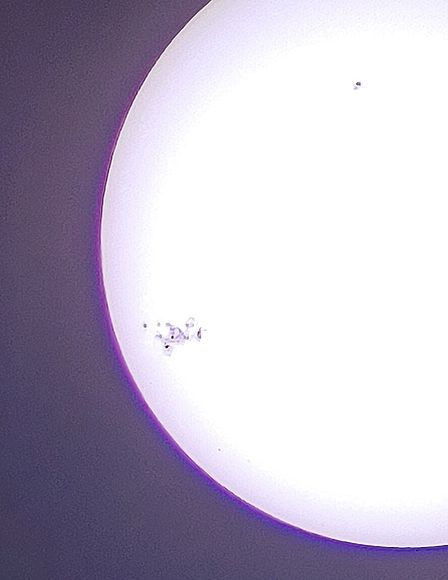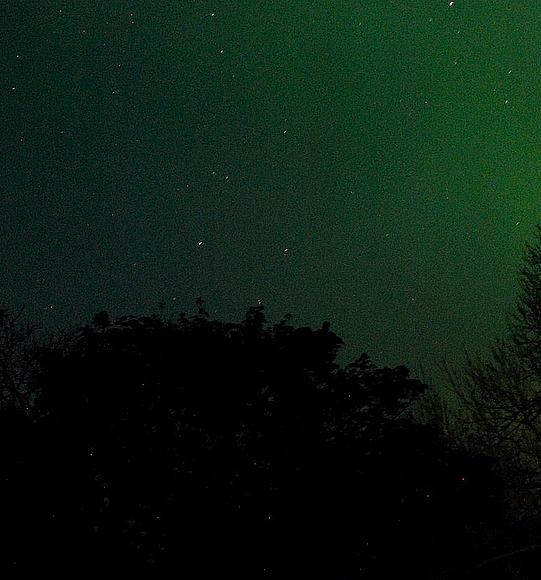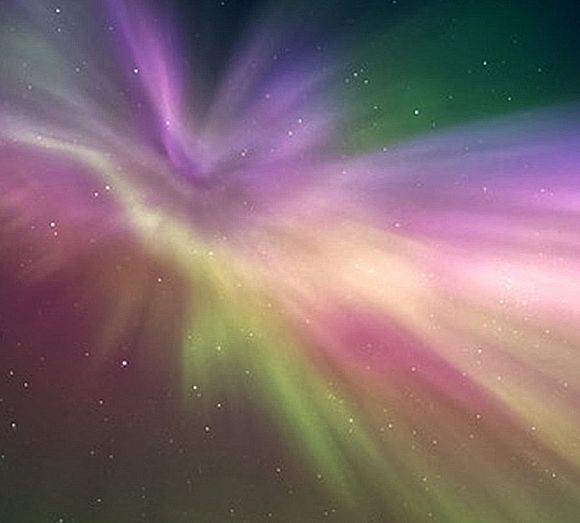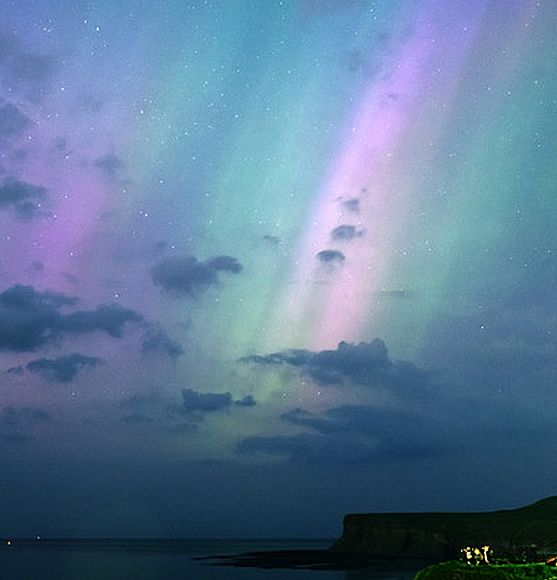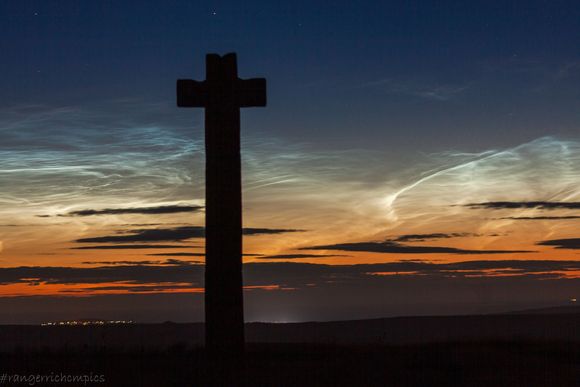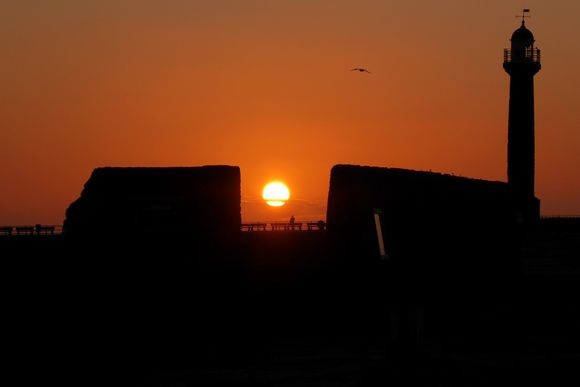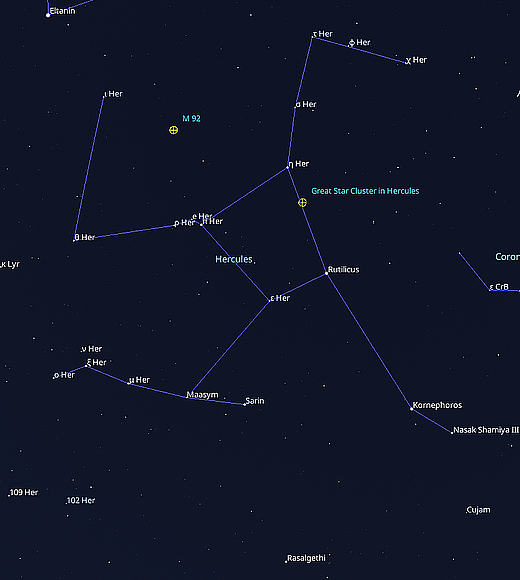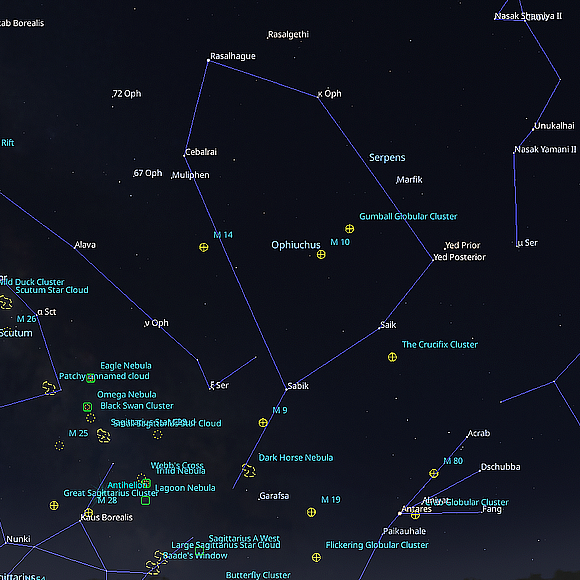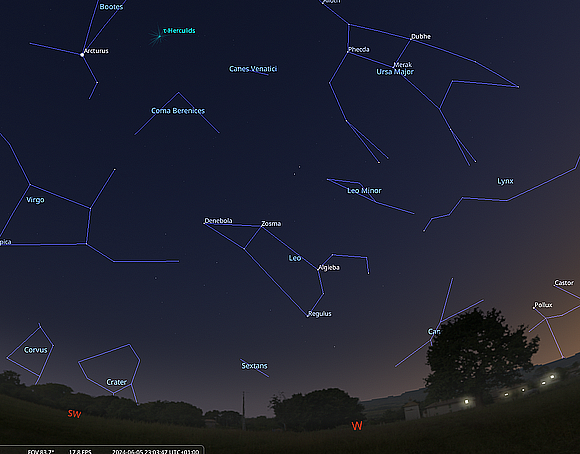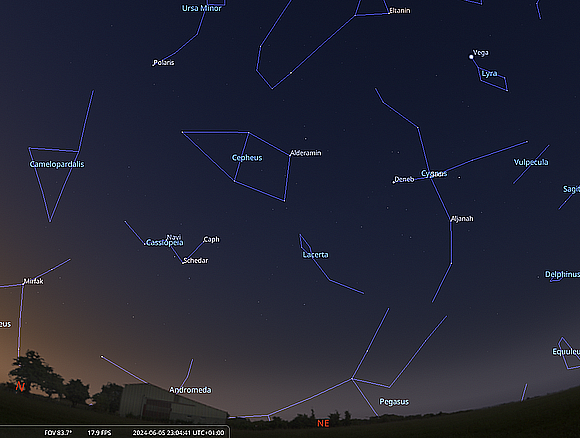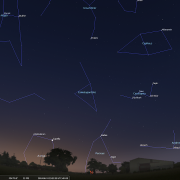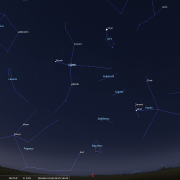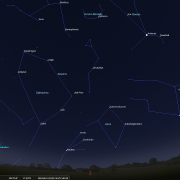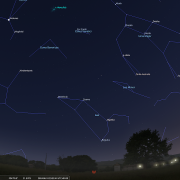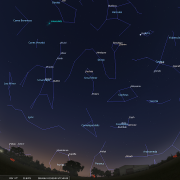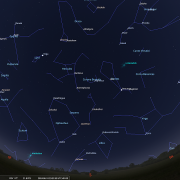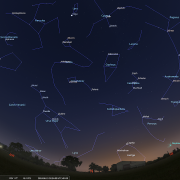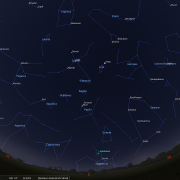In this month's Sky Notes:
- Planetary Skylights.
- June Meteors, Noctilucent cloud and Aurora reports.
- Summer Solstice.
- June Night Sky.
- June 2024 Sky Charts.
Planetary Skylights: A Brief Guide to June's Night Sky
June is another quiet month for planetary action, although there is the prospect of some limited planetary observations during early morning hours for those dedicated enough to make the effort (or who suffer from insomnia). I suspect most observers will be happy to wait until August.
 Saturn continues to draw away from the Sun in the early dawn sky. It will be apparent from UK latitudes low in the ESE by 02:30hrs BST as June commences, and before 01:00hrs by the end of the month, but this still represents a limited observing window of no more than 3 hours. Saturn will at least be gaining in elevation above the horizon from 12 degrees to around 25 degrees as July commences.
Saturn continues to draw away from the Sun in the early dawn sky. It will be apparent from UK latitudes low in the ESE by 02:30hrs BST as June commences, and before 01:00hrs by the end of the month, but this still represents a limited observing window of no more than 3 hours. Saturn will at least be gaining in elevation above the horizon from 12 degrees to around 25 degrees as July commences.
Telescope observations of Saturn will gradually improve over the course of the month, although 'seeing' will still be marginal, and anyone expecting to view the glorious ring system may be disappointed to note that the tilt of orientation is little more than 2 degrees. This will increase to 5 degrees later in the year before finally closing at ring plane crossing in March of 2025 when the rings will be practically edge on.
Should you be a very early riser (or late to bed) on June 27th and 28th, a waning quarter Moon resides right and left of Saturn respectively during the early morning hours.
 Mars continues to struggle in the early morning sky, seemingly taking an eternity to move away from the Sun's glare a full seven months after being in solar conjunction. At the start of June, Mars sits just 8 degrees above the ENE horizon at 04:00hrs BST – just as twilight relinquishes its grip to the new day. Matters will only slowly improve, Mars climbing to 13 degrees by 03:30hrs at the end of June. It will be another 2-3 months before circumstances really allow meaningful observations to be made. The waning Moon lies above right of Mars on July 1st at 03:00hrs BST (before June notes are publicised). Observers may note the return of Jupiter towards the end of June, although it will be very low in the ENE and growing light overwhelms it within 30 mins.
Mars continues to struggle in the early morning sky, seemingly taking an eternity to move away from the Sun's glare a full seven months after being in solar conjunction. At the start of June, Mars sits just 8 degrees above the ENE horizon at 04:00hrs BST – just as twilight relinquishes its grip to the new day. Matters will only slowly improve, Mars climbing to 13 degrees by 03:30hrs at the end of June. It will be another 2-3 months before circumstances really allow meaningful observations to be made. The waning Moon lies above right of Mars on July 1st at 03:00hrs BST (before June notes are publicised). Observers may note the return of Jupiter towards the end of June, although it will be very low in the ENE and growing light overwhelms it within 30 mins.
June Meteors - May Auroral Displays - Noctilucent Cloud Watch
Meteor activity is rather sparse in June, with no well-defined meteor showers of note to speak of. The low levels of observed activity are due to several reasons. The short, light nights are certainly one factor, but the low activity that is present chiefly comes from the ecliptic, which from the UK is low to south at this time of year. The minor showers that are apparent produce only a handful of meteors at best.
The Ophiuchids, the radiant of which lies near Theta Ophiuchi - approximately 15 degrees east of Antares, may produce 5 or so per hour with peaks on June 9th and 19th. The Beta Taurids are associated with debris left by Comet P/Encke, but unfortunately the shower occurs during daylight hours over the course of June. Radio detection methods do seem to indicate the shower is one of the strongest 'radio meteor showers' of the year. The Alpha Cygnids yields just a few meteors per hour near the end of June. The radiant lies close to Deneb, which is at least high in the NE sky!
Aurora Watch!!
There have been some spectacular displays of Aurora in the past month visible from all parts of the UK and indeed across the northern hemisphere. The display on May 10-11th was especially significant, witnessed by millions across the globe (except Mark...don't ask!). WDAS members were able to capture some fine images of this particular display, some of which are seen below.
Paul Ming captured the aurora above the Ravenscar headland from Fylingthorpe on May 11th between 01:00 - 02:00hrs. (Click for larger image)
Looking high to the North from Fylingthorpe - May 11th between 01:00 - 02:00hrs.
(Click for larger image)
Looking East from Fylingthorpe - May 11th between 01:00 - 02:00hrs. (Click for larger image) All the above images by Paul Ming.
The activity was due to five coronal mass ejections (CME's) that left the Sun that week, during a flurry of X flares. When this material swamped Earth’s magnetic field a few days later, fantastic auroral displays were witnessed. The sunspot group responsible was imaged by WDAS members Phil Richards and Elaine and John McCue (see below).
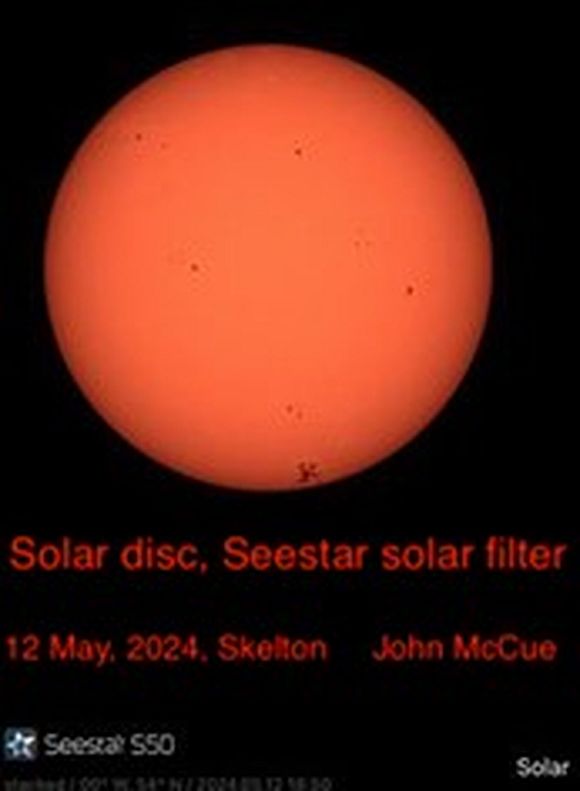
John McCue captured the solar disk and sunspot grouping using a Seestar on May 12th. I have enlarged image - apolgies for clarity.
With the Sun nearing the peak of its current solar cycle the longevity of larger, more complex, sunspot groupings increase with a greater chance of continued CMEs from these groups resulting in further aurora visible from our latitude. It is definitely a case of keeping tabs on aurora alerts - especially early June, and not be caught out - like Mark was! More member's images below.
And here are a few more spectacular images taken from Saltburn by Peter McCue - John McCue's brother.
Noctilucent Cloud - June Peak
There have been no sightings of noctilucent cloud so far this year, however June offers up the best chance, with the peak of the noctilucent cloud season normally falling between mid-June to mid-July. This rather beautiful type of cloud formation only forms during the summer months above the northern horizon long after sunset, often around midnight. Its appearance is quite distinct, shining quite brightly, exhibiting a characteristic silvery-blue hue and filamentary in structure. It forms exclusively between latitudes 50 and 60 degrees north, at an altitude of over 50 miles, five times higher than normal clouds. The cloud forms when water vapour condenses at the low temperatures that prevail at such altitudes onto particles suspended in the air. Most certainly keep an eye out to the north as twilight deepens.
The Summer Solstice
The summer solstice in the northern hemisphere falls on June 21st this year, when the Sun reaches its greatest altitude in the sky on the ecliptic; the path it takes across the sky during a year. Solstice comes from the Latin word’s sol, meaning Sun and sistere, meaning to come to a stop or stand still. On the day of the June solstice, the Sun reaches its northernmost position, as seen from the Earth. At that moment, its zenith does not move north or south as during most other days of the year, but it stands still at the Tropic of Cancer. It then reverses its direction and starts moving south again. The opposite happens during the December solstice. Then, the Sun reaches its southernmost position in the sky corresponding to the Tropic of Capricorn, standing still before reverses its direction towards the north.
It is often wrongly assumed that Earth lies closer to the Sun at this time of year; in fact, the opposite is true. Earth is furthest from the Sun on July 4th at almost 95 million miles, nearly 3 million miles more than when at its closest approach in early January. It is the inclination of the northern hemisphere towards the sun which causes days to feel warmer due to the higher concentration of sunlight per unit area. Think of this as being like a spotlight directed onto to the palm of your hand, your palm feels hotter under direct radiation, whereas when the light is tilted, the angle reduces the heat intensity. The actual intensity of solar radiation in June is equivalent to approximately 1.2KW of heat for each square metre on the surface!
The position of the summer solstice currently stands on the Gemini-Taurus constellation border, but it wasn’t always so. Thousands of years ago this position stood before the stars of Cancer in the northern hemisphere but has subsequently shifted due of the effects of precession, Earth’s slow axial wobble. From our latitude we never see the Sun overhead, however anywhere between latitude 23.5 degrees North, and latitude 23.5 degrees South, the Sun can appear directly overhead, casting no shadows, a phenomenon noted in antiquity by astronomers. Because the summer solstice then stood before the stars of the constellation Cancer, the latitude of 23.5 degrees north eventually became known as the tropic of Cancer. Similarly, the Sun then stood before the stars of Capricorn when at its southern limit on the ecliptic (the winter solstice) 23.5 degrees south of the celestial equator and the origin of the tropic of Capricorn.
Astronomers and scientists use the date of the June solstice to mark the beginning of summer in the Northern Hemisphere, for meteorologists, on the other hand, summer began almost three weeks earlier on June 1. Although known as the longest day, earliest sunrise and latest sunset times do not occur on the summer solstice date. From Whitby earliest sunrise falls around June 16th at 04:25hrs, whilst latest sunset occurs on June 25th at 21:42hrs. It is the duration of useable daylight which reaches a maximum on the 21st, which from Whitby is just over 17 hours, leaving a meagre 4 hours of semi darkness. Considered by most people as the date of the June solstice, the 21st is not the only date it can happen. In fact, the summer solstice can fall anytime between June 20 and June 22. June 22 solstices are rare - the last one took place in 1975 and there won't be another one until 2203!
June Night Sky
As we delve into the summer months in the northern hemisphere, the short, light nights at UK latitudes considerably impact observational astronomy. Observers of deep sky objects are limited to a post-midnight period barely spanning a couple of hours, and even then, the absence of astronomical twilight filters out which deep sky objects are visible in the eyepiece. Yes, the coming couple of months are reserved for the dedicated, retired or the insomniac! Pre-midnight casual ‘stargazing’ is also limited with naked eye stars of magnitude +3 and above hidden in nautical twilight, making constellation recognition somewhat more challenging.
By 22:30hrs just a sprinkling of isolated jewels pricks through velvet blue tapestry. First to catch the eye high to the ENE is the steely blue hue of Vega in the small constellation of Lyra. At 26 light years, Vega is relatively nearby and is the most brilliant member of the ‘summer triangle’ and second brightest star in the summer sky after Arcturus. Vega is a striking sight in binoculars or a telescope. It is believed to be only 450 million years old, but is already halfway through its lifespan, being twice as massive as our sun. Vying with Vega to emerge first, Arcturus is a tad brighter in apparent magnitude, but located in lighter skies high in the south it is often second to Vega. Arcturus (or Alpha Boötes) is classed as a K type orange giant, perhaps 750 million years older than our Sun. It lies approximately 37 light years distant and has one of the largest proper motions (genuine stellar movement) through space of any bright star, cutting across the Sun's path as it orbits the Milky Way galaxy. In less than half a million years binoculars will be required to spot it at all!
To the left of Boötes sits the distinctive circlet of stars marking Corona Borealis - the Northern Crown. The centre star in the tiara is known as Alphecca or Gemma. High to the south - upper left of Corona resides the fifth largest of the modern constellations - the sprawling outline of Hercules - a relatively faint constellation given its status; indeed, it is the largest of the 50 constellations which have no stars brighter than magnitude +2.5. It is best identified by the 'keystone' asterism marking the central hub of the group. All 4 stars within this arrangement are not particularly conspicuous, zeta herculis or Rutilicus is the brightest (mag + 2.85) member residing bottom right of the arrangement. The brightest star in Hercules; beta Heculis or Kornephoros (mag +2.75) lies some distance below Rutilicus. Alpha Herculis or Rasalgethi, meaning "Head of the Kneeler" in Arabic, is a little fainter (mag +3) a triple star the primary component of which is some 400 times the Sun's diameter. Hercules may be lacking in bright stars but does contain two notable deep sky objects. M13 - the great globular cluster, for many the finest of its type in the northern hemisphere, but M92 is also a fine globular cluster worthy of a visit, too often overlooked for M13.
Below Hercules yet another large, but ill-defined constellation; Ophiuchus, stretches down to the S horizon. Ophiuchus the serpent bearer is the 11th largest constellation in the heavens containing just 5 stars brighter than mag+5. Its brightest star called Rasalhague ("head of the serpent charmer"), has an apparent magnitude of +2.07. It resides at the apex of the 'roof' sat atop the 'hay barn gable end' outline of stars marking the main body of Ophiuchus. It lies left of, and below Raselghetti in Hercules, so that both 'alpha stars' of these respective large constellations reside quite close in the night sky. The constellation contains many deep sky objects (DSO's) including seven Messier objects; M9, M10, M12, M14, M19, M62 & M107, all of which are globular clusters. Ophiuchus also currently contains Barnard's Star, which at 5.96 light years is the nearest star to the Sun after the three components of the Alpha Centauri system, making it the closest star north of the celestial equator. At mag +9.5 it requires binoculars to spot it and lies to the left of Beta Ophiuchi (Cebalria).
As we continue down the spine of the southern aspect of the sky, and those constellations visible before midnight, we finally drop onto Scorpius stradling the southern horizon. It is a pity that from UK shores Scorpius never fully rises, being the one constellation the outline of which really does resemble the creature it represents - a Scorpion, but the tail is lost below our horizon. Antares, its chief star is certainly one of the most orange bright stars visible from the UK, classed as red super giant some 360 million miles in diameter and considered a supernova candidate. It is over 300 light-years distant. Unlike the previous two constellations where there are only a few stars brighter than mag +3, Scorpius contains 13! Though many are hidden or shrouded in haze.
With the Milky Way passing through Scorpius, not surprisingly many deep sky objects are located within its borders including 4 Messier objects; M4, M6, M7, and M80, the first and last being globular clusters, whilst M6 and M7 are galactic open clusters. M4 can be located to the right of Antares, whilst M6 & M7 barely rise from our shores, the optimum period to look for them being late June around midnight, due south, just a few degrees above a flat horizon.
Much of the central strip of the southern sky in June is taken up by the constellations highlighted above, but what about the rest of the sky? Surprisingly, part of Gemini, a seasonal winter constellation, highlighted by Castor and Pollux remains above the NW horizon for early June, the twins finally succumbing by mid-month. The giant Sea Snake of Hydra has by now mostly departed, the remaining portion submerging below the SW horizon in early June taking with it the constellations of Corvus and Crater. Even Leo, the signature group of spring highlighted by Regulus at the foot of the 'sickle' asterism, will have mostly departed by the month's end. The Sower of seeds, Virgo, will remain visible all month low in the WSW its leading star Spica, not setting until early July.
Turning to the east, the most southerly member of the ‘summer triangle’ – Altair in Aquila the Eagle, may be located above ESE horizon. Altair is the nearest of the bright summer luminaries visible from UK shores, a mere 16 light-years away. Turn to the north to locate conspicuous Capella in Auriga just above the NNW horizon, a star often mistaken for the North Star during summer months as it dips down on its circumpolar journey around the pole. The true pole or North Star (Polaris) stands 54 degrees high in the north (from this latitude) in Ursa Minor and is much less prominent. It can be tracked down using the ‘pointer’ stars in the bowl of the ‘plough’ or ‘big dipper’ asterism in Ursa Major located high to the NW. Curving up and around the 'box' of the Little Bear are the stars of Draco, the faint quadrilateral of stars marking the head resting above Hercules.
Below Draco in the NE King Cepheus surveys the scene, his Queen; Cassiopeia - the 'W' constellation sits on her throne below, not too far above the NE horizon. Finally, look east of Vega, for the third and least brilliant member of the summer triangle, Deneb, in the constellation of Cygnus. Deneb is ranked 19th brightest star in the sky, but its immense distance; around 1700 light years, masks Deneb’s real luminosity, perhaps 80-100 thousand times more than our Sun. After a relatively short life span - less than 20 million years, Deneb will grow to become a vast super giant star, before ending its days in cataclysmic fashion - as a supernova, and what a talking point that will be!
Serious deep sky observing may then be difficult and inconvenient, but if conditions are mild and clear it remains a joy just to step outside and admire the ever-changing aspect of the night sky.
June 2024 Sky Charts
Additional Image Credits:
- Planets and Comets where not otherwise mentioned: NASA
- Sky Charts: Stellarium Software and Starry Night Pro Plus 8
- Log in to post comments


